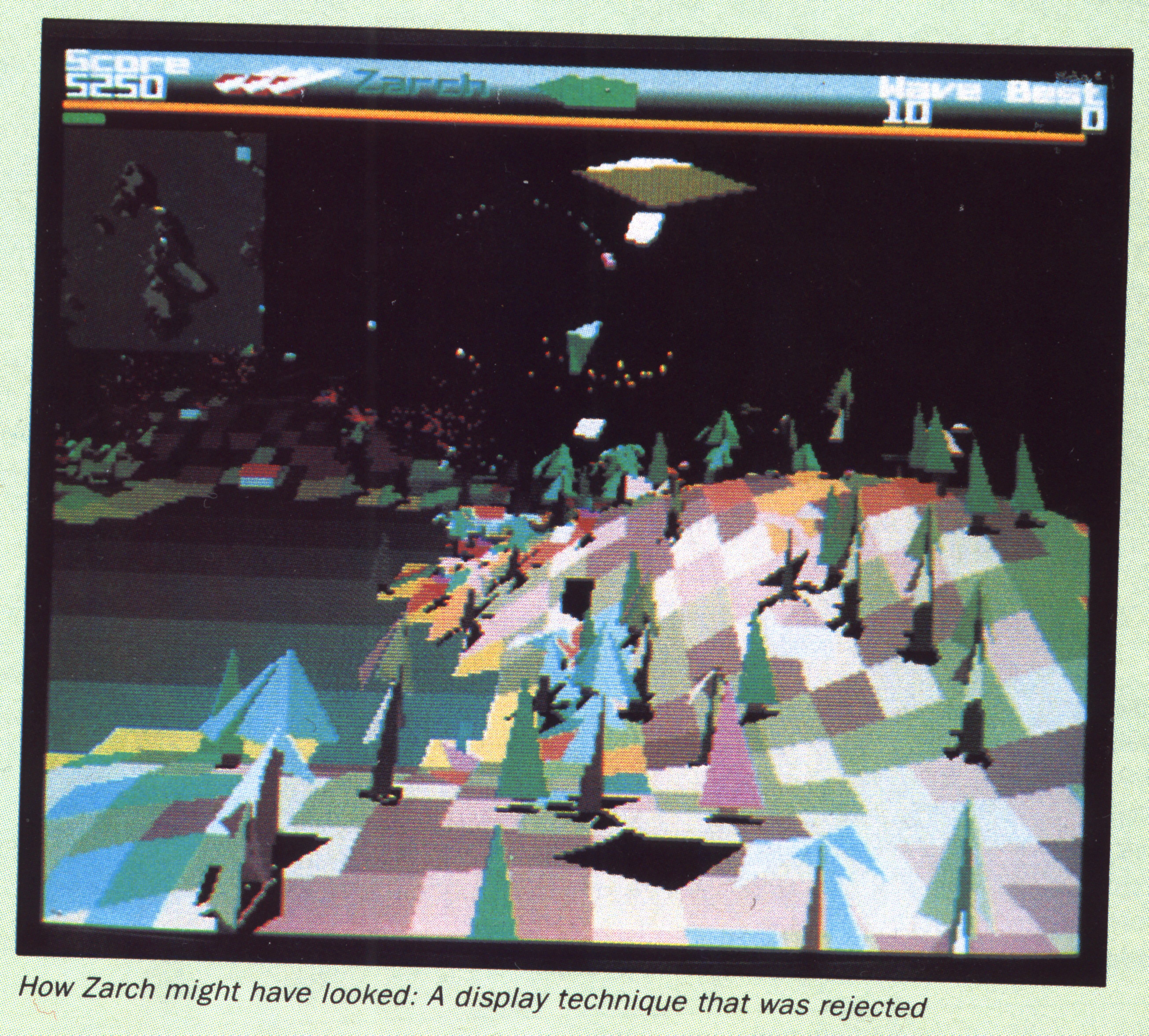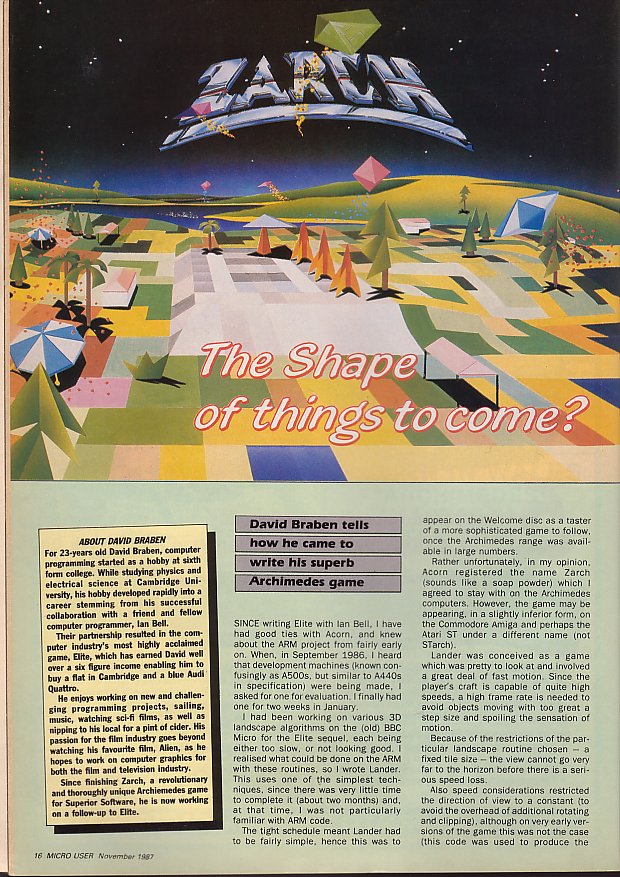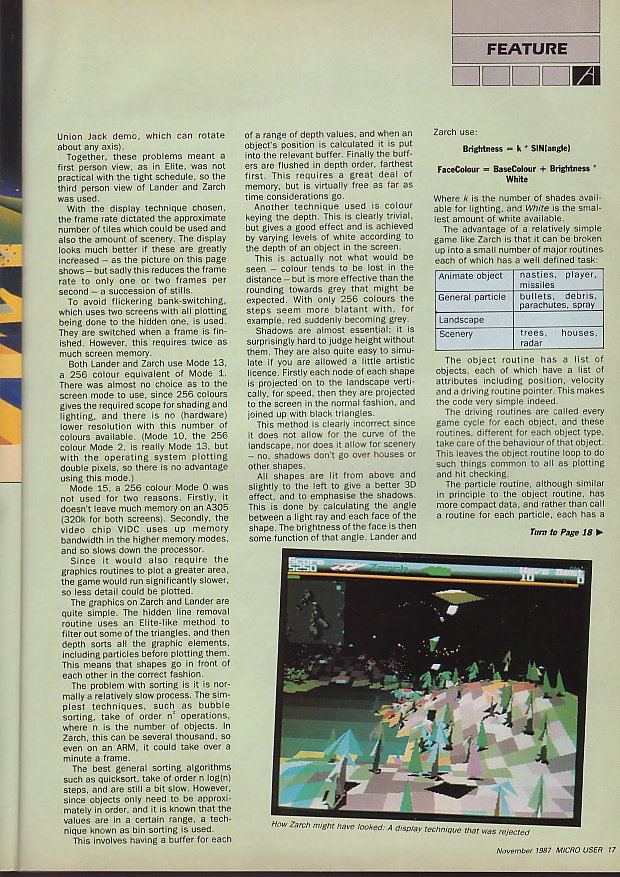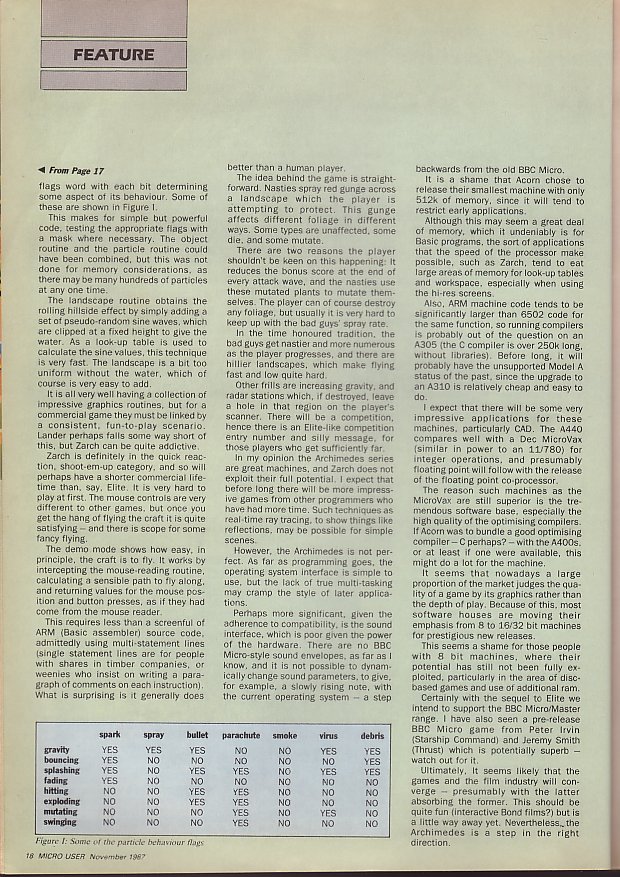Finally restricting my overuse of commas.
Interviewed David Braben over the phone while sitting on the fire escape after work. Hilariously, my voice recorders's battery ran out half way through. I didn't notice until reviewing the playback on my drive home, leaving me parked at a petrol station rapidly supplementing my written notes with the information otherwise only in my head.
Lessons there kids: take written notes, and always use fresh batteries.
Although I was keen on Zarch (well, Virus really) Braben will always be one of my childhood heroes for Elite. Oddly I've also interviewed co-creator Ian Bell, although in a different context, to see if he'd like to do some work for us at physics SDK developer MathEngine. (He didn't ). 'CdrJameson' is a handle I've used consistently online since the Lancaster University Bulletin Board in 1993, although it's getting a bit crowded and these days I find I have to fall back on 'CdrJamison' more often, which is even more obscure.
There's an excellent (and little known) 'The Making of Elite' contained as a chapter in Francis Spufford's generally excellent Backroom Boys. It's a better option than Ste Curran's version for Edge, which includes the fanboy bait that Generation Ships exist in game, including a faked picture. Unfortunately, it also contains a couple of factual errors that rather undermine the impact of the deliberate one.
Thanks for this one go obviously to David Braben for giving up his time to do the interview and answer my follow up questions, Stuart Campbell for helping me sort out the Archimedes emulation, Matt Cocker at The Micro User site for the magazine scans, and helpful people who'd probably rather not be named for helping me find the game image.When one of the authors of Elite took a short break on a planet, the results were spectacular. Edge takes a look at David Braben’s other classic.
Despite the obvious attractions of Zarch’s landscape, the sensible player spent their time trying to get as far away from it as possible.
“Because of the way the mouse control works the tendency is to shoot downwards.”, Braben explains. “You end up in a war of height against the bad guys. Inevitably you end up leaving the ground behind”.
Unfortunately, with little time available to rethink the entire design and control system there wasn’t much that could be done.
“We appreciated that fairly early on, which was one of the reasons we made sure that the Seeders land. You have to come quite low to shoot them”
Although this also introduces a game enhancing tension, as the player must leave the safety of altitude, Braben admits there was an element of wanting to “Rub the player’s nose in the ground. Look at all this work I’ve done!”
ZarchInSpace.jpg (Zarch, Archimedes)
Despite the attractions of the landscape, the player often spent long periods high up in the air. Lander lacked even Zarch’s starfield, which added visual interest and a sense of motion.
Despite the critical and commercial success, there were a number of design issues that weren’t quite perfected. The most immediately noticeable was the unusual control system. Moving the mouse left and right did not rotate the hoverplane, instead the player indicated which compass direction they wanted to point at, and the ship would swing around accordingly. Greater movement resulted in a steeper angle. Unfortunately it was extremely sensitive.
“It was a bit of a git.”, Braben admits. “It was so much dependent on how good your mouse was. In some cases [it was] virtually unplayable. You could play it on keyboard, don’t forget”
Despite this, once the system became familiar you could pull off impressive manoeuvres. Following feedback from fans Braben decided to keep it for the sequel. “I think Virus is easier, but its still an absolute git”
ZarchUpsideDown.jpg (Zarch, Archimedes)
The unusual mouse controls were highly sensitive. Having your craft suddenly flip upside down and accelerate towards the ground was a common experience for the new player.
In early 1987 things weren’t going quite to plan. David Braben and Ian Bell were still working together on the sequel to their massive critical and commercial hit Elite. Only enthusiasm was waning, and they weren’t making much progress.
Through friends at Acorn Braben had heard about a new machine in the pipeline, something altogether far more powerful than the aging BBC. The Acorn Archimedes was in an entirely new and exciting league. “I asked if I could get my hands on one, and they asked me if I could do something they could use for promoting the machine.” recalls Braben.
This was certainly going to be a change of pace from the slow development of the epic sequel. He would have only three months to produce a complete game.
In the end, he made two.
“What happened is that I did a game called Lander, which was given away free with the Archimedes. This had to be ready in double-quick time because it had to go on a disk and be duplicated to ship with the machine.”
The short timescale meant that an Elite style epic was out of the question. Braben grabbed ingredients already to hand, and mixed them together with a strong dose of technical ambition. He decided to take an idea he’d worked with some years earlier on Acorn’s Atom, the companies first home machine, and update it for their latest.
Meteors was never available commercially, but it’s not difficult to picture the Asteroids inspired game. The player’s rotating and thrusting ship now battled against gravity above a planet’s surface, in the same tradition that would later give us Thrust and Oids. Braben decided to keep the eponymous rocks which also came under gravity’s influence, raining down on the player and shattering when they hit the planet’s surface. It was simple concept, but satisfying to play and straightforward.
Lander would be a three dimensional version of Meteors. The simple Asteroids ‘v’ would be replaced by a ‘hoverplane’ reminiscent of a ship from Elite. Shots fired forward, and thrust came from the base. To move the craft the player dipped the nose in the direction they wanted to go and simply applied thrust. The steeper the angle of the nose, the more they would accelerate horizontally at the expense of height. With movement in place all that was needed was to turn a simple line into a landscape. Then he could start throwing rocks at it.
The Archimedes’ was an entirely new machine. Centred around a custom designed 32-bit RISC processor it clearly had power but Braben would have to figure out how it worked as he went along.
As it turned out, a lot of it didn’t.
“I was actually doing all the programming through the BBC Micro because the machine was missing its operating system. It didn’t even have a disk drive, that’s how basic it was.”
Gallingly, the final machine promised features that would dramatically speed up 3D applications but were missing from the machine Acorn supplied to Braben.
“In the prototype version of the chip the multiply operation just didn’t work. It just wasn’t there. It didn’t exist.“
Nevertheless he set to work realising what would become the series’ most distinctive feature. As a graphical demonstration of the Archimedes power the landscape would be key.
“I already had ideas of how to do a patchwork landscape because I’d been playing around with ideas of how I might do it for the Elite game”, he remembers. Freed from the constraints of the humble BBC Braben realised that what had proved unsatisfactory before could really fly on the Archimedes. “Having a computer that could actually do it made life a whole lot easier”, he says with typical understatement.
Lander’s world painted an idyllic picture. It was a pleasure to just skim along the hilltops admiring the scenery. Interface elements such as score and fuel were pushed unobtrusively to the top to let the world take centre stage. The solid, coloured graphics were a natural evolutionary step forwards, but were a world away from Elite’s cold vectors. Hills were lush with greenery, shading into yellow as the ground approached the water. Beach tents and houses were scattered around giving a sense of scale, life and human warmth. The Archimedes impressive 256 colour palette allowed a unique degree of subtlety. Lighting effects meant that hills had bright and shady sides, and everything faded smoothly into the distance. Everything in the world cast a realistic shadow, actually critical for correctly judging height and position, but so natural as to be completely unobtrusive. Despite being able to see that the surface was only paper thin, it felt real.
This patchwork of hills, valleys and lakes, as with the solar systems in Elite, were dynamically generated. This was essential if they were ever to be used in another multiple-galaxy epic and here allowed Braben to put together a range of worlds quickly and simply. The heights of the regularly-sized tiles were determined by deforming the flat planet with a series of sine waves shooting off in random directions. With a few of these the landscape looked artificial, like an egg box, but as the number and variety increased it took on a more natural appearance without losing its smooth, rolling quality. Values below a certain height were capped and marked as water, giving a constant sea level and further breaking up the unnatural regularity. It was clear that Braben was enjoying his work.
“When you’re presented with such a fancy toy, a gadget freak’s gadget, what I wanted to be spending my time on was playing around the rendering features, because it was such an opportunity”
Of course, as with many of the best boys’ toys, Braben had constructed a delightfully neat and well ordered world in order to smash it up.
“The initial idea … was making the landscape deform, so you end up with it becoming ever more cratered.”, he recalls, “That didn’t really happen … to the extent I wanted it to”
Unfortunately, in what has become a familiar problem since, the design that had worked so well for Meteors didn’t quite take to the added dimension. Although successful as a graphical demonstration, Lander couldn’t really hold the player’s interest. There was a lot of potential there, and the ship and landscape were impressive, but it needed more game.
Enter Zarch.
“Zarch is quite a different game, but it used the same landscape infrastructure”, says Braben.
At first glance the two games appear identical, but this
similarity is superficial. In play, they are very different. With
Lander sent off for mastering and testing after only two months, Braben
had only a month left, so this reuse was a crucial step.
Fortunately he was now equipped with a upgraded prototype system,
featuring such luxuries as its own keyboard, and development could
proceeded at a rapid pace.
“Conceptually there were a lot of different elements that fed into Zarch.”, he explains, “All sorts of things from Defender to Space Invaders.”.
“Because the development period was so tight I had to go for things that were relatively safe to code and weren’t going to cause massive gameplay problems.”
Braben choose to update his favourite elements from the classics.
“I love the idea in Defender where you’re attacked by a craft that’s relatively easy to deal with, and yet it suddenly goes mutant and it’s a pig to deal with. Those concepts all feed in. Like Galaxian, where the things swoop around. Things that are fun in these games. They’d be fun to realise in 3D.”
The lush landscape was brought more into Zarch’s gameplay. The tranquil, Eden-like world became slowly distorted by virus particles spread by the invaders, becoming covered in angry red lesions as a Seeder passed overhead.
“I loved the idea of a landscape that gradually became corrupted.”, he states, “Every landscape item either mutates or dies or something special happens”
These arcade additions changed a demonstration into a frantic arcade battle. The player would climb higher and higher to tackle an incoming Fighter, then spiral towards the ground to destroy a lone parked Seeder, turning sharply and firing the braking jets just inches above the ground.
In true arcade fashion defeat was inevitable. You simply kept going for as long as possible, occasionally rewarded with new missiles, landscapes, or extra hoverplanes. To add more of a challenge, every few levels the gravity would also increase playing havoc with your expectations of how the hoverplane handled.
The critics and public loved it. The free copy of Lander with every Archimedes proved a useful demo not only for the machine’s power, but also for the charms of Zarch. It rapidly became, and stayed, the machine’s best-selling game. Unfortunately the machine was expensive and never became truly found its place in gamer’s hearts. This scarcity made the game unobtainable for most. It would remain a whispered legend in the playground, at least until the following year when a renamed and tweaked Virus appeared for the 16-bit machines.
Zarch’s elegant simplicity became not just a demonstration of the Archimedes power but a flag bearer for the new generation of 3D games. It gave us hope and reassurance. It was going to be all right. You could combine gameplay and stunning graphics.
This was the future, and it was looking good.
All in all, not bad for three months work.
LanderFlying.jpg (Lander, Archimedes)
Whilst the fixed camera did away with the need for extra controls, and allowed several optimisations, flying and shooting out of the screen could be disorientating.
ZarchParticles.jpg (Zarch, Archimedes)
To enhance the sense of motion, Braben tried to make as many actions as possible generate clouds of particles. Thrusting, shooting and of course explosions all contributed to the frantic air.
STMutatedLandscape.jpg (Virus, ST)
With the conversion to the sixteen-bit machines Braben took the chance to rename the game Virus. He’d never been keen on Zarch, claiming it ‘sounds like a soap powder’
SpectrumVirus.jpg (Virus, Spectrum. Obv.)
Braben was so impressed when programmer Steve Dunn approached him out of the blue with a completed landscape engine that he gave permission for this unlikely Spectrum port of Virus

LargeLandscape.jpg (Experimental, Archimedes. Supplied by Braben for an article he wrote at the time. Scanned from magazine, as original lost)
Braben experimented with broader views, but the frame rate suffered. A dynamic rendering system he tried unfortunately shrank the landscape whenever enemy craft appeared, and was dropped.



